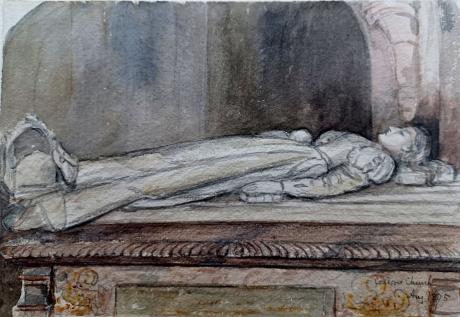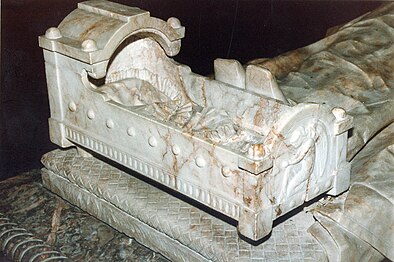inscribed and dated "The Tomb of Alice Mary Cholmondeley Condover Church Aug 1875" and sigend with initials "LWT"
Tom and Laura Taylor and thence by descent
In March 1863, following the death of his cousin, Edward William Smythe Owen (1793–1863), Thomas Cholmondeley (1823–1864) inherited Condover Hall and the large estate adjacent, and took the name of Owen as a condition of the inheritance. A year later he married Victoria Alexandrina Cotes, daughter of John Cotes and Lady Louisa Jenkinson, daughter of Charles Jenkinson, later 3rd Earl of Liverpool and a godchild of Queen Victoria. He travelled to Italy for his wedding tour and in Florence he was "seized with a malignant fever" on 10 April and died there on 20 April 1864. His brother, Reginald, who had met him in Florence, carried back his remains to England, and he is buried in Condover churchyard.
In the parish church at Condover there is a marble monument to Thomas Cholmondeley by George Frederic Watts (1817–1904), featuring a kneeling bearded figure of the deceased, wearing boots, a cloak and a soldier's tunic, with his hands clasping a sword, looking out across the choir stalls in front of him, into the chancel.
The Condover estate devised to Reginald on the death of his brother, Thomas, in March 1864. His country seat, Condover Hall, is generally regarded as "the finest stone manor-house in Shropshire." He also owned a house in London. Originally in single occupation as No. 37 Palace Gate, this large red-brick house at the corner with Canning Place was built in about 1869–70 for Reginald Cholmondeley, to whom Cubitts granted a ninety-nine-year lease from September 1870, at £100 per annum. The architect was Frederick Pepys Cockerell, who also worked for Cholmondeley on the restoration of his country seat, Condover Hall, Shropshire. As well as being a considerable landowner, Cholmondeley was an enthusiastic amateur sculptor of some accomplishment. Many of the elaborate sculptural decorations at Condover Hall are his work.

On 17 October 1867 at Rostherne, Cholmondeley married Alice Mary Egerton (1836–27 November 1868), daughter of William Egerton, 1st Baron Egerton of Tatton and Charlotte Elizabeth Loftus, daughter of John Loftus, 2nd Marquess of Ely. His younger brother, the Reverend Richard Hugh Cholmondeley, officiated at the ceremony.
His new wife was an artist and a poet and the couple were well-suited but the marriage would be short-lived. Alice died in childbirth on 27 November and was buried on 3 December 1868; her infant daughter, Alice, died three weeks after her mother, on 11 December and was buried on 19 December in the parish church at Condover.
In the Church of St Mary and St Andrew, Condover, there is a very affecting monument to Alice Cholmondeley that was sculpted by her husband of one year. It features a recumbent effigy of Alice, with her infant daughter by her side and an empty cradle at her feet.
Cholmondeley also sculpted the recumbent effigy of his cousin, Blanche Heber (d. 1870), at St Luke's Church, Hodnet.
In 1871 he published Poems by A.C., a volume of poems by his late wife and dedicated to Robert Browning, and in 1875, Emblems, a volume of her drawings. A presentation copy of the latter was given to the banker, George Rae.
-
Monument to Alice Cholmondeley by Reginald Cholmondeley, Church of St Mary and St Andrew, Condover
-
Monument to Alice Cholmondeley (detail)
-
Monument to Alice Cholmondeley (detail)
Laura Wilson Barker (6 March 1819 – 22 May 1905), was a composer, performer and artist, sometimes also referred to as Laura Barker, Laura W Taylor or "Mrs Tom Taylor".
She was born in Thirkleby, North Yorkshire, third daughter of a clergyman, the Rev. Thomas Barker. She studied privately with Cipriani Potter and became an accomplished pianist and violinist. As a young girl Barker performed with both Louis Spohr and Paganini. She began composing in the mid-1830s - her Seven Romances for voice and guitar were published in 1837. From around 1843 until 1855 she taught music at York School for the Blind. During this period some of her compositions - including a symphony in manuscript, on 19 April 1845 - were performed at York Choral Society concerts.
On 19 June 1855 she married the English dramatist, critic, biographer, public servant, and editor of Punch magazine Tom Taylor. Barker contributed music to at least one of her husband's plays, an overture and entr'acte to Joan of Arc (1871), and provided harmonisations as an appendix to his translation of Ballads and Songs of Brittany (1865).
Her other works include the cantata Enone (1850), the violin sonata A Country Walk (1860), theatre music for As You Like It, (April 1880), Songs of Youth (1884), string quartets, madrigals and solo songs. Her choral setting of Keats's A Prophecy, composed in 1850, was performed for the first time 49 years later at the Hovingham Festival in 1899. The composer was present.
Several of Barker's paintings hang at Smallhythe Place in Kent, Ellen Terry's house.
Barker lived with her husband and family at 84 Lavender Sweep, Battersea. There were two children: the artist John Wycliffe Taylor (1859–1925), and Laura Lucy Arnold Taylor (1863–1940). The Sunday musical soirees at the house attracted many well-known attendees, including Lewis Carroll, Charles Dickens, Henry Irving, Charles Reade, Alfred Tennyson, Ellen Terry and William Makepeace Thackeray.
Tom Taylor died suddenly at his home in 1880 at the age of 62. After his death, his widow retired to Porch House, Coleshill in Buckinghamshire, where she died on 22 May 1905, aged 86.




